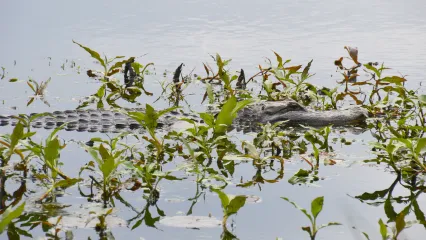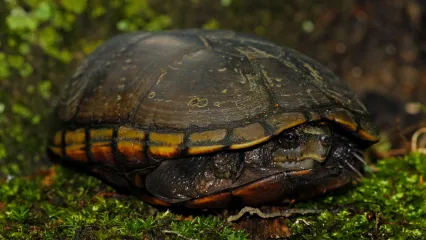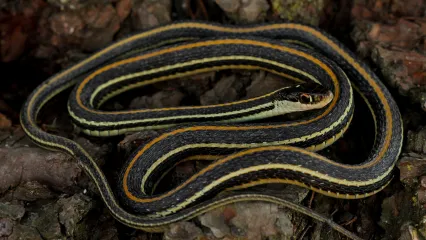
Description
American alligators (Alligator mississippiensis) are grayish-black above with a light-colored belly. Young alligators tend to be more colorful with highlights of yellow and white. Their bodies are armored with large, bony plates. The ears, eyes and nostrils are situated near the top of the head. Valve-like structures on the ears and nostrils close when the alligator is underwater. Alligators can see while underwater because they have transparent eyelids. While they are graceful in the water, they tend to move clumsily on land.
American alligators have very strong jaws lined with about of 80 teeth. They use their teeth to capture their prey. Alligators swallow their food whole because they cannot chew. Losing teeth while capturing prey is not uncommon. Fortunately, each tooth has an underlying tooth precursor, so any lost teeth are quickly regrown.
When the temperature is lower than 75 degrees, alligators hibernate in burrows known as "alligator holes." Even when they are outside of the holes, they can still endure long periods in the cold. When the water is beginning to freeze, they submerge their bodies and keep their nostrils above the surface so they can still breath. This behavior sometimes causes them to be trapped in the ice until a thaw allows them to move again.
American alligators are difficult to find in Oklahoma. But they can be found in remote and marshy areas in the southeastern corner of the state.
Size
Adult male alligators can grow up to 15 feet long, and females typically reach nearly 10 feet.
Habitat
Alligators are often basking with their eyes and nostrils just above the water. They are mostly found in swamps and marshes, but sometimes they are found in rivers, lakes and other bodies of water. In Oklahoma, alligators can be found in Red Slough Wildlife Management Area and the Little River National Wildlife Refuge. Choctaw County and McCurtain County have the highest number of these long-lived reptiles, but they can also be found in other southern counties.
Life Cycle
In far southeastern Oklahoma, "living dinosaurs" still exist. A survivor from the Triassic Period, the American alligator has remained unchanged for 65 million years.
American alligators usually mate around June, and mating season lasts about six to eight weeks. They typically mate underwater during the end of their courtship period. In June and July, females form their nests on high banks. There, she lays 20 to 30 eggs which are covered with nesting material. The covering creates a constant temperature in the nest so the female does not have to keep it warm.
The temperature of the eggs during incubation determines whether the hatchlings are male or female. Temperatures less than 85 degrees produce females, temperatures greater than 91 degrees produces males, temperatures in between produce both females and males. As soon as the offspring break their shells, they make a distinctive call. The mother, very protective of the nest, then comes to dig out the eggs. At this point, the hatchlings are vulnerable to predators such as raccoons, otters, snakes, fish, frogs, herons and larger alligators.
Adolescent alligators eat a selection of small animals, mostly insects, small fish and frogs. As they grow, so does their appetite. They will start eating larger prey. Large alligators can eat any prospective meal that comes within range. They mostly feed on fish, turtles, birds and small mammals.


